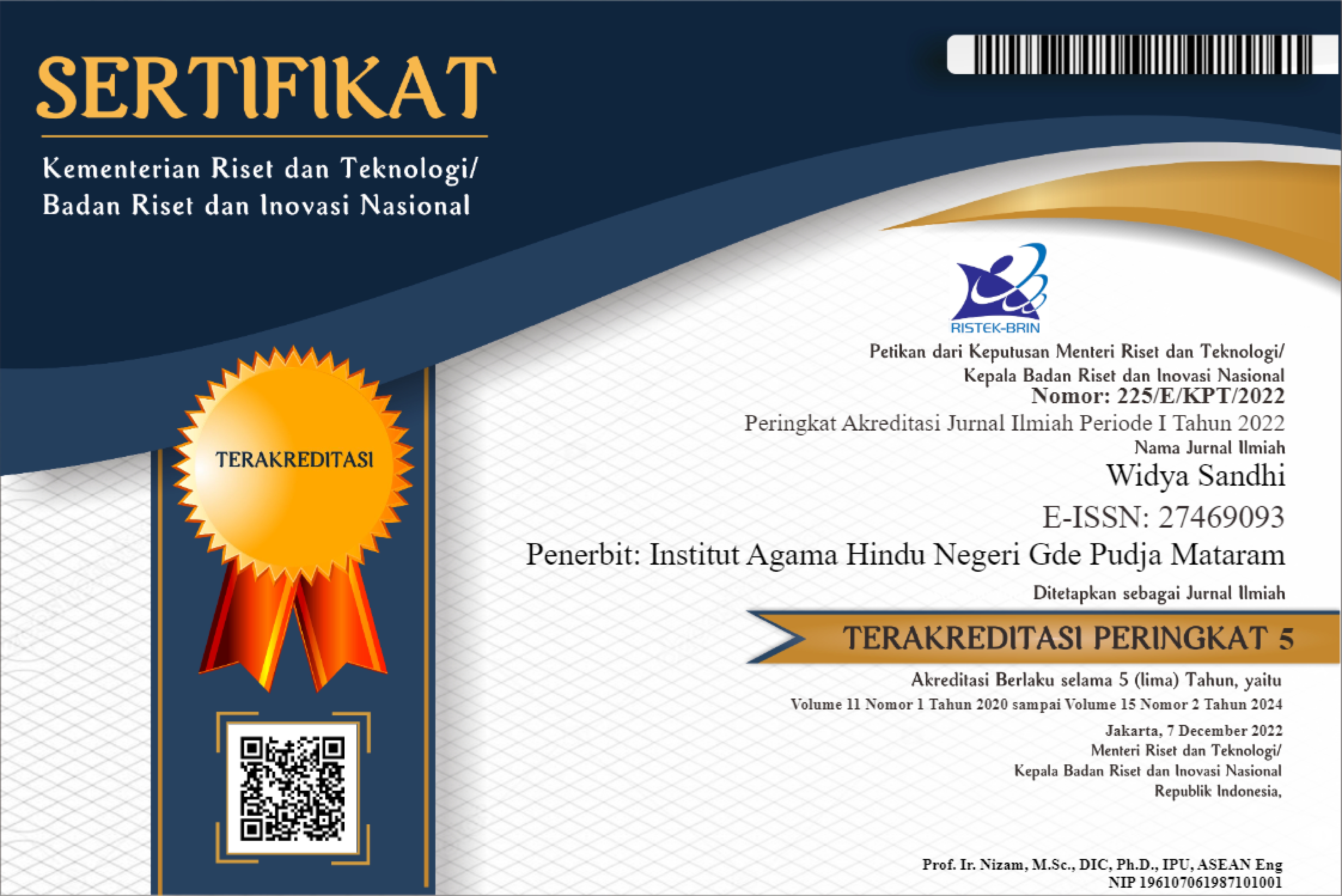THE IMPLEMENTATION OF RITUAL COMMUNICATION IN THE PERSPECTIVE OF RELIGIOUS TOLERANCE AT THE SARASUTA HOLY PLACE
Abstract
This article aims to explain the implementation of ritual communication carried out by the Balinese-Hindu and Sasak-Islamic people at the Sarasuta holy place, Lingsar Subsubdistrict, West Lombok Regency from the perspective of religious tolerance. The method used in producing this study is interpretive qualitative using a case study model. Based on the research results found three findings. First, ritual communication presented by followers of two different religions, namely Sasak-Islam and Balinese-Hindu as the implementation of a belief system to improve the quality of life. Second, the Muslim-Sasak community carries out ritual communication as the implementation of the customary traditions inherited by their predecessors, while the Balinese-Hindu community implements ritual communication as the continuation of Hindu religious culture. Third, the ritual communication of people of different religions in the Sarasuta holy place in the social dimension tends to strengthen religious tolerance.
References
Amran, A. (2015). Peranan agama dalam perubahan sosial masyarakat. HIKMAH: Jurnal Ilmu Dakwah Dan Komunikasi Islam, 2(1), 23-39
Chandra, E. (2020). Dinamika Komunikasi Sosial Etnis Bali Dengan Etnis Sasak Di Kota Mataram. Danapati: Jurnal Ilmu Komunikasi, 1(1), 26-34.
Gunadha, I.B. 2001. Meningkatkan Pembinaan Kerukunan Hidup Umat Beragama Guna Mencegah Disintegrasi Bangsa, Denpasar: Laporan Penelitian Universitas Hindu Indonesia
Hendropuspito, D. 1983. Sosiologi Agama. Jakarta: Yayasan Kanisius
Ishomuddin. 2002. Pengantar Sosiologi Agama. Jakarta: Ghalia Indonesia
Jayadi, S. (2018). Rasionalisasi Tindakan Sosial Masyarakat Suku Sasak Terhadap Tradisi Perang Topat (Studi Kasus Masyarakat Islam Sasak Lombok Barat). Jurnal Sosiologi Agama, 11(1), 13-34.
Kembarawan, I. G. K. (2018). Sidhikara Sebagai Penguatan Ikatan Sosial Masyarakat Bali Di Lombok. Widya Sandhi, 9(1).
Maretha, N. K. W. (2015). Kontruksi Kerukunan Antar Umat Beragama Berbasis Ikatan
Kekerabatan Polong Renten di Kecamatan Pemenang Kabupaten Lombok Utara. GaneC Swara, 9.
Nazir, Muh. 2009. Metode Penelitian. Bogor: Ghalia Indonesia.
Sendra, I. M. (2016). Paradigma Kepariwisataan Bali Tahun 1930-An: Studi Genealogi Kepariwisataan Budaya. Jurnal Kajian Bali (Journal of Bali Studies), 6(2), 97-124.
Soetrisno, Loekman. 2003. Konflik Sosial: Studi Kasus Di Indonesia. Yogyakarta: Rajidu Press
Sumada. (2011). Ritual Kebon Ode Sebagai Wahana Membangun Solidaritas Sosial Penganut Islam Wetu Telu dan Penganut Hindu di Kecamatan Lingsar Kabupaten Lombok Barat. Mataram: Laporan Penelitian STAHN Gde Pudja
Suprapto. (2013). Semerbak Dupa di Pulau Seribu Mesjid. Jakarta: Prenadamedia Group
Yewangoe, A. A. 2001. Agama dan kerukunan. BPK Gunung Mulia.
Yin, Robert K. 2004. Studi Kasus, Desain & Metode. Terjemahan Djauzi Mudzakir. Jakarta: PT Raja Grafindo Persada
Tim Penyusun. 2006. Buku pendidikan Agama Hindu untuk Perguruan Tinggi. Surabaya: Paramita
Wirawan, I. W. A. (2019). Identifikasi Pendidikan Multikultural Dalam Festival Seni Budaya Pada Komunitas Sasak-Islam Dan Bali-Hindu Di Bayan, Kabupaten Lombok Utara. Widyacarya: Jurnal Pendidikan, Agama dan Budaya, 3(1), 89-100.

This work is licensed under a Creative Commons Attribution-NonCommercial-ShareAlike 4.0 International License.
Authors who publish with this journal agree to the following terms:
- Authors retain copyright and grant the journal right of first publication with the work simultaneously licensed under a Creative Commons Attribution-ShareAlike 4.0 International License. that allows others to share the work with an acknowledgment of the work's authorship and initial publication in this journal.
- Authors are able to enter into separate, additional contractual arrangements for the non-exclusive distribution of the journal's published version of the work (e.g., post it to an institutional repository or publish it in a book), with an acknowledgment of its initial publication in this journal.
- Authors are permitted and encouraged to post their work online (e.g., in institutional repositories or on their website) prior to and during the submission process, as it can lead to productive exchanges, as well as earlier and greater citation of published work (See The Effect of Open Access).






.jpg)




